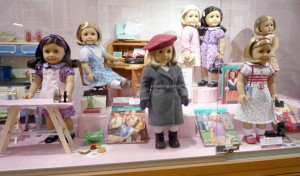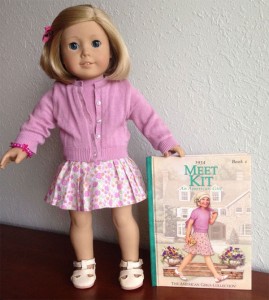My American Girl doll: more about having than playing

Display at an American Girl doll store in Chicago. Photo: Ambernectar 13, Creative Commons, some rights reserved
This morning, in the process of finding really substantive articles for “inspiration,” fellow NCPR intern Natalie Dignam stumbled upon an article called “What your American Girl Doll Says About the Rest of Your Life.” Together, we began to recall fragments of our memories of said dolls. Web guy Dale also chimed in: Apparently the American Girl craze had reached more people than I thought.
Thinking about it, it makes sense. So many little girls’ childhoods were influenced by the trend (Dale’s daughter included). However, looking back, I can’t actually recall ever playing with my doll. I dressed her up, took her places, bought her more accessories than any doll could ever need and lived in a constant state of fear that my dog might eat her.
But having an American Girl doll in elementary school sort of secured your popularity. In other words, when you’re a 7-year-old girl, having an American Girl doll at recess sort of always ensured that you’d always have a friend to play with.
At school, I would watch enviously as the other girls cradled their Bitty Babies during recess and braided their dolls’ hair during story time. As time passed, it seemed harder and harder to get by without having one.
When I (by chance) received my first catalog in the bed of mail, it was magical. It was as if the mailman knew of my dilemma. I would plop the catalog in my mom’s lap and make her read it with me cover to cover. Overall, it took about a year of persistence for Santa (played by both the mailman/my mom) to bring me my own doll.

American Girl doll “Kit Kittredge,” with book, offered on eBay with a starting bid of $69.99. Photo: thediaperbaker1
At the time, there wasn’t an American Girl doll that looked “just like me,” so we had to settle for Kit Kittredge, who was the first doll since Pleasant Company sold the company to Mattel. While Kit and I definitely had some good times dressing up in matching outfits for church and figure skating competitions, she turned into more of a liability than any 7-year-old needs. Not only was my mom’s stern voice constantly reminding me of how expensive she was, the doll herself was a liability. I mean, come on! If you pull the string on the back of her neck, her head pops off and she has to go to the American Girl Doll Hospital (and we really couldn’t afford that).
Girls wanted them and parents had to pay for them. Truthfully, that’s what I really remember the dolls for—being overpriced. It was always fairly well-established that American Girl dolls weren’t exactly cheap. Perhaps that’s why I struggle to recall actually doing anything with my doll. I spent more time buying her off-brand accessories from JoAnn Fabrics than actually making lasting memories with the doll.
So how much are the memories of an American Girl doll actually worth?
A quick eBay search shows that the dolls are selling on wide-ranging spectrum from $5-$5,000… the most expensive dolls being the historical dolls from the ‘90s. In May 2013, The Washington Post reported that the historical dolls that the company was founded on have been retired to the Upstate Doll Farm (sounds like a scene from a bad horror movie) and have been replaced with the Girl of the Year or the My American Girl who Looks Just Like You, neither of which possess stories of courage and strength that could compare to Addy’s or Josefina’s.
The remodeling of the American Girl dolls was meant to capture the essence of today’s modern girls. At the time, I probably would have preferred a doll that was a little more like me. But looking back, I think my doll influenced my development: we’re both tomboyish, both perspective journalists, both lived through an economic depression of sorts, and we both love our friends and families. So maybe she had a bigger influence on my childhood than I thought she did.
I guess I’m saying that although these dolls were overpriced, but 14 years later, when I called my mom at work asking for her to clear up the fuzzy details, her response surprised me. She said that having an American Girl doll was a rite of passage for the both of us: as mother and daughter.







